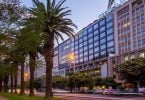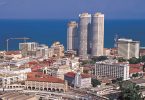SAN JOSE, CA – San Jose is grounding itself in the wide world of green. Going beyond the standard programs, initiatives all throughout San Jose are forcefully changing the way business is done. From hotels, to the Convention Center, to City organizations and the Mineta International Airport – all are making strides to ensure that San Jose puts its best carbon footprint forward. The vision is to make this kind of environmental responsibility the standard so visitors can “stay to play!” for years to come. Initiatives include:
Green Hotels
One of the few hotels in Northern California to utilize an Ozone Laundry Plan, Hotel Valencia on Santana Row debuted this program in February to save water, gas and electricity as the cycles run a shorter time and use cold water to conserve. Also unique to Hotel Valencia is a Heatsvr, a liquid pool blanket technology that reduces temperature and is expected to save 15-40 percent of natural gas usage for the pool and spa. Low-flow toilets and shower heads along with biodegradable key cards, no use of Styrofoam products and electronic mailings all contribute to keeping one of the most popular hotels in San Jose seeing green. Calculated by energystar.com, as of May 23, 2008 the hotel has reduced its carbon footprint by 47,739.57 pounds.
The “Green Team” at Dolce Hayes Mansion monitors environmental practices and maintains new standards sustainability. The “Green Team” also researches and coordinates property and staff involvement in local environmental projects or programs. In addition, Hayes Mansion provides biodegradable food to-go containers, uses local and sustainable food and beverage products and energy efficient appliances and lights bulbs.
The San Jose City Council recently recognized the Hilton San Jose as a Green Business. The staff uses energy saving printers, faxes, etc., sensored lighting and offers a linen re-use program to each guest. Cups, lids and straws are made from 100 percent US grown corn, also known as PLA plastic. Use of PLA plastic saves 10 gallons of gasoline for every case of 20 oz. cups.
The Clarion Hotel in San Jose saves approximately $15,000 a year with a PG&E initiative that provides air conditioning motion sensors to save energy and water conservation systems for their sprinklers, showers and faucets. They use a paperless reporting program and a guest linen program, where guests can reuse their own towels and sheets.
The DoubleTree Hotel partners with many green organizations, including the Arbor Day Foundation, to plant new trees in the area. They are proud members of the California Green Lodging Program and the Green Meeting Industry Council. The hotel is a member of the Earthcare program, which allows a 100-guestroom hotel to save 72,000 gallons of water through linen and towel reuse. Eco-friendly materials are used for renovations and remodels, and energy efficient appliances are purchased. Staff also focuses on avoiding printing brochures and correspondence whenever possible.
The San Jose Marriott stands out by offering a “Green Meeting Planner Package” that includes environmentally friendly meeting room writing pads. For every 4 pads consumed, the equivalent of one mature tree is saved, 733 gallons of water are saved, 144 pounds of air emissions and 29 pounds of solid waste is reduced. Marriott San Jose also uses ‘Green Works’ cleaners, Brita filters, corn starch drinking cups that are 100 percent recyclable and is building toward linen-less tables in all meeting spaces for 2009.
Initiated by Fairmont San Jose and adopted by all the Fairmont hotels across the state, this San Jose hotel offers complimentary parking to the overnight guests who drive Hybrid cars. The Fairmont San Jose also implements several green programs pioneered by Fairmont headquarters, such as the Green Partnership Program — a comprehensive commitment to minimizing hotels’ impact on the planet, accompanied by a guidebook on sustainable best practices in the lodging industry. The program emphasizes sustainable and responsible practices such as recycling, kitchen-waste diversion, retrofitting energy-efficient lighting, conducting community-outreach programs and buying green power. The Fairmont’s Eco-Meet program helps meeting planners by providing a meeting structure that encourages maximum waste diversion and environmental awareness for conference delegates.
Eco-Friendly Restaurants
Bella Mia in downtown San Jose is a Certified Green Business and participates in Pacific Gas & Electric’s (PG&E) ‘Save Energy Program,’ which uses local, seasonal products, energy efficient lighting and recycles all possible products.
Tanglewood, a newly-opened restaurant on Santana Row, maintains the ‘Green’ theme with presenting diners with the motto of “Dining in the Season.” This restaurant, the newest concept from Left Bank Restaurant Group, presents a menu that celebrates the day’s best seasonal ingredients, grown and raised on small, local sustainable farms, ranches and fisheries. Staff invites guests to reconnect with the rhythm of nature’s seasons while you enjoy the harvest of this unique American cuisine.
Manresa is the showcase for the inventive cuisine of executive chef David Kinch. Influenced by French and modern Catalan cooking, Chef Kinch finds inspiration from American ingenuity and the vast bounty that California has to offer. Manresa’s biodynamic vegetables are grown exclusively for Manresa at Cynthia Sandberg’s Love Apple Farm in the nearby Santa Cruz Mountains and harvested in the morning for the evening menu. Love Apple Farm originally became known for growing 100 varieties of heirloom tomatoes each year but the farm is now the exclusive kitchen garden for this restaurant. Join Manresa for the ultimate farm-to-table experience.
Village California Bistro and Wine Bar features California-inspired cuisine focusing on the bounty of artisan-quality, seasonal ingredients right in their backyard from the Wine Country to the Central Valley and the Pacific waters surrounding the Northern California coast and Monterey Bay. Emphasizing freshness, quality of ingredients and classic cooking techniques, their chef David Starr creates ever-changing seasonal menus.
Sustainable Wineries
The Viticulture Association of the Santa Cruz Mountains supports sustainable winegrape growing and has worked to promote sustainable practices in the region’s vineyards. They have brought the programs of the Sustainable Winegrape Growers Alliance to the region, including the Self-Assessment, Energy Efficiency and Ecosystem Management workshops. The meeting programs stress best vineyard and sustainable practices, including cover crops, erosion control, canopy management and more.
The Association uses the Code of Sustainable Winegrowing Practices as a guide to describe the value of sustainability in wineries. Since the first sustainable workshops in 2004, the region has seen an increase in the adoption of sustainable vineyard practices. Some have adopted alternative energy such as solar and biodiesel. Several vineyards grow organically, and one is certified organic by the California Certified Organic Farmers.
Only 25 minutes from Palo Alto or San Jose or 50 minutes from San Francisco, Cooper-Garrod Vineyard is a family-owned and operated 28-acre estate vineyard and winery.
Located above the village of Saratoga on the unirrigated hillsides in the eastern Santa Cruz Mountains, this winery uses solar power photovoltaic systems to independently convert the sun’s light into electricity. The winery Web site is linked to a live Web site by Akeena Solar that monitors the 17 kilowatt solar array located at the winery that proves one aspect of their efforts toward sustainability.
Overlooking Monterey Bay sits Silver Mountain, a winery and vineyard that prides itself on addressing a fundamental concern for the environment and being a proponent of sustainable and organic practices for viticulture and other food sources.
Only organically-approved and naturally-occurring substances in all vineyard applications are employed, which means that no chemical herbicides, insecticides, fungicides or synthetic fertilizers are used in the vineyard. While implementing these methods are costly and labor intensive, organic farming produces fresher fruit and healthier vines than traditional methods using man-made chemicals. The result is award-winning wine with more intensity and stronger flavors than its counterparts.
As of August 2007, Kathryn Kennedy Estate Vineyard has officially stepped up sustainability to the next level and achieved Certified Organic status. Rigorous standards of certification will be maintained by California Certified Organic Farmers based in Santa Cruz, CA. Over the last 10 years, president and winegrower Marty Mathis has began to transition the vineyard’s practices toward a sustainable vineyard regime with a holistic approach. This procedure includes pesticide avoidance and weed killer, maintaining soil health with farm composting on site, energy reduction from electric and biodiesel transportation for around the land lot, as well as a recycling policy for all possible materials.
Regan Estate Vineyards subscribes to the concept and practice of sustainability through working in harmony with nature and integrating three main concepts: environmental sustainability, where the staff seeks to minimize the impact on nature so as to help sustain a healthy environment for future generations; economic sustainability, where operations are part of a fiscally-responsible business and striving to treat their employees and community with respect to promote socially-equitable business practices. These all make every effort to have a minimal impact on the air, water and soil of the environment.
Environmentally-Friendly Attractions
Last October, The Tech Museum of Innovation and Team San Jose partnered with SunPower to plan the installation of solar panels on the roof of neighboring Parkside Hall. Once the panels are in place, they will provide at least 10 percent of energy needed by The Tech and will avoid approximately 200 million pounds of carbon dioxide annually associated with conventional power generation. Both companies are excited about leading by example to show how affordable, clean and reliable solar power is today.
The Tech Museum also welcomed a new, permanent exhibit last September called ‘Green By Design.’ This exhibit act as a reminder about how Silicon Valley houses some of the most advanced environmental initiatives and advocates in the US. Inside ‘Green By Design’ is where the guests can design and race a hybrid car in an arcade-like racing game, try out harnessing wind and water power with self-made turbines and experiment with designing a solar concentrator. This innovative display shows visitors the importance of learning about renewable energy sources and new technologies and solutions being developed to meet our growing energy needs. The space sets out to challenge and inspire the next generation of inventors and engineers to come up with intelligent green designs.
Responsible Meetings
The San Jose Convention & Visitor’s Bureau and Team San Jose are working diligently to reduce the impact on the environment. Recycling ranges from paper products, to carpeting and food waste. What cannot be recycled, like furniture, scrap metal and foam boards, are donated to non-profit organizations for repurposing, such as the Resource Area for Teaching (RAFT) and local schools. The company is working to become a Certified Green Business by Santa Clara County and is a member of PG&E’s ‘Climate Smart Program’ to create a climate neutral footprint.
Team San Jose uses electrically-powered service carts around the Convention Center and Cultural Facilities, and they set the thermostat at 68 degrees for heating and 78 degrees for cooling to maximize energy conservation. An energy efficient LED marquee was installed for advertising. Local vendors within 150 miles are used for the freshest ingredients for the available organic meals. Since May 2008, the Convention & Visitor’s Bureau and Team San Jose have one of the few West Coast centers that have the ability to compost all products that are provided through the Convention Center and Cultural Facilities for an additional fee. Team San Jose also offers products that are recyclable or compostable, such as plates, cups, silverware, napkins and box lunch containers.
Mineta San Jose International Airport Leads Environmental Conservation
The Mineta San Jose International Airport (SJC) is one of the country’s leading airports regarding environmental conservation and sustainability. With the continuing upgrades to the airport, San Jose’s airport has plans to keep raising the bar on green initiatives for many years to come.
Terminal B and the North Concourse are being built with dual-plumbing systems so the buildings can use recycled water for non-potable purposes. The Airport is investing more than $2 million for the installation of a recycled water distribution system that can serve the new buildings and landscape irrigation systems.
The Airport has converted its entire 34-bus shuttle fleet from diesel to compressed natural gas, which will reduce the emissions by nearly 100 tons annually, compared to 2001 levels. The Compressed Natural Gas fueling station for the shuttle buses has also been open to the public since 2003 and provides lower cost alternative fuel.
An Airport incentive program and mini-grants have resulted in the conversion to more than 122 clean-fuel taxis and door-to-door shuttles that now account for over 47 percent of taxi trips at the Airport.
The Airport partners with the San Jose Environmental Services Department to use goats and sheep for weed control in open areas adjacent to the Airport, reducing the use of herbicides and mechanical equipment that both use fuel and release exhaust.
In the past year the Airport’s rate of solid waste recycling has more than doubled, from 8.8 percent to 18.9 percent, as a result of the Airport’s new off-site sorting process by the City’s materials recovery contractor that manages waste from terminals, tenants and aircraft. Trash going to landfill has been reduced from 2200 tons in 2006-07 to 1978 tons in 2007-08.
City of San Jose’s Green Vision
On October 30, 2007, the San Jose City Council adopted Green Vision, a fifteen-year plan to transform San Jose into a world center of clean technology innovation, promote cutting-edge sustainable practices and demonstrate that the goals of economic growth, environmental stewardship and fiscal responsibility are inextricably linked.
San Jose is leading the world in solar technology, alternative fuels, new transportation systems, efficient lighting and energy monitoring systems innovation. San Jose successfully pioneered many commonplace environmental activities, from curbside recycling to its urban growth boundary. The City of San Jose will advance its Green Vision with the following goals set for the next 15 years:
– Creating 25,000 Clean Tech jobs as the World Center of Clean Tech Innovation
– Receive 100 percent of their electrical power from renewable sources
– Build or retrofit 50 million square feet of green buildings
– Divert 100 percent of the waste from their landfill and convert it to energy
– Ensure 100 percent of public fleet vehicles run on alternative fuels.
Since 2001, San Jose government has significantly reduced its energy consumption by 200 million kilowatt hours through institution of basic efficiency efforts, resulting in an estimated savings of $20 million. They’ve set a goal of reducing their per capita energy consumption by half in the next 15 years and to convert to using 100 percent renewable electrical power. For more information, visit www.sanjoseca.gov/greenvision .






















